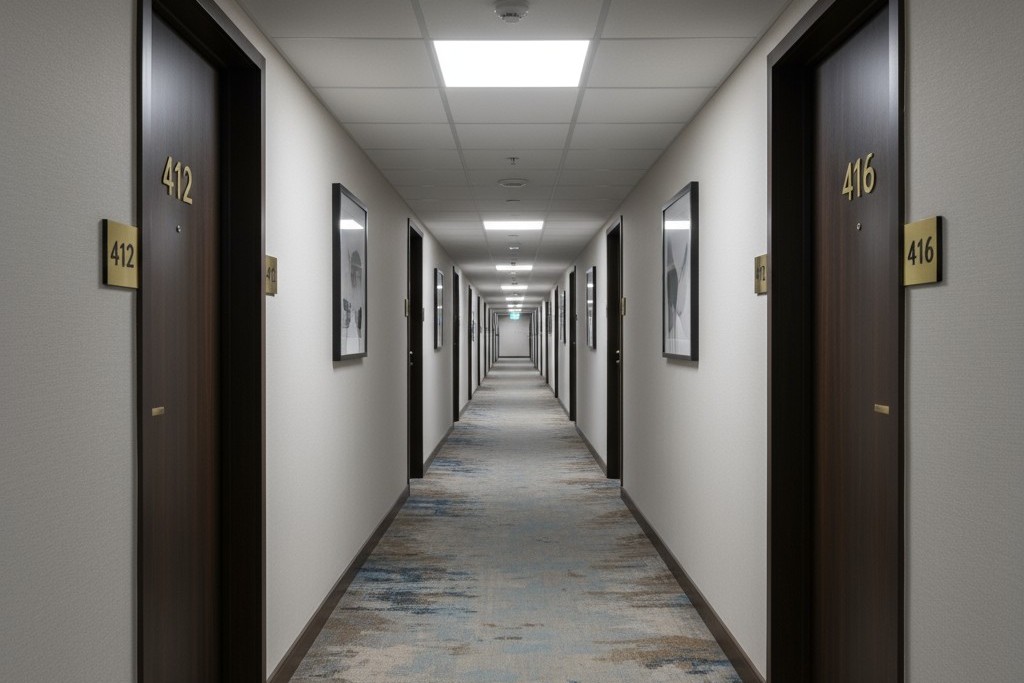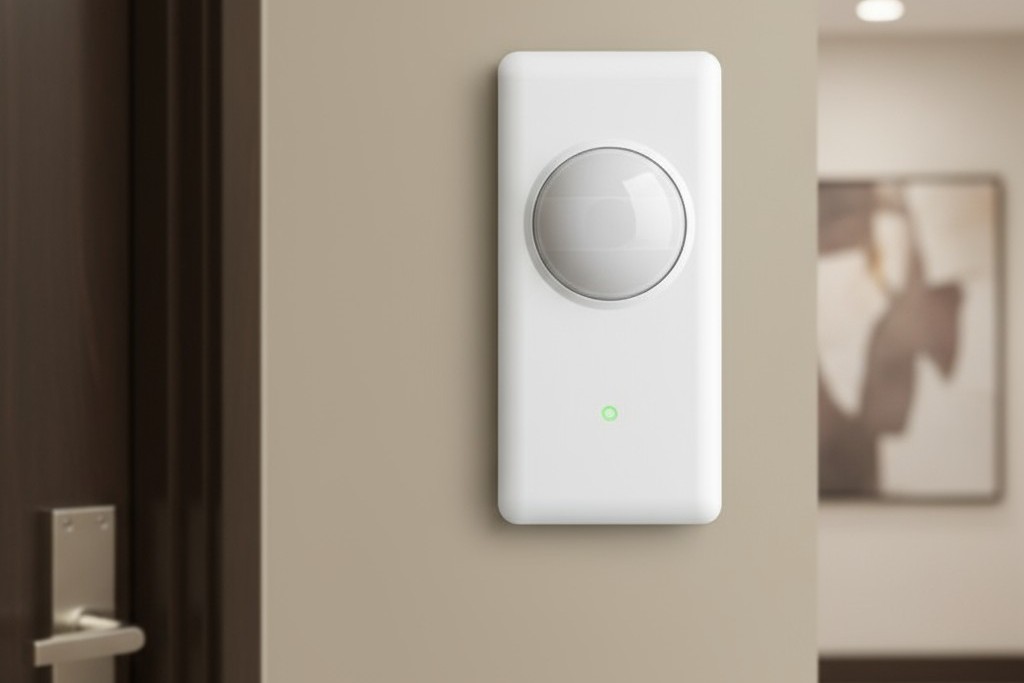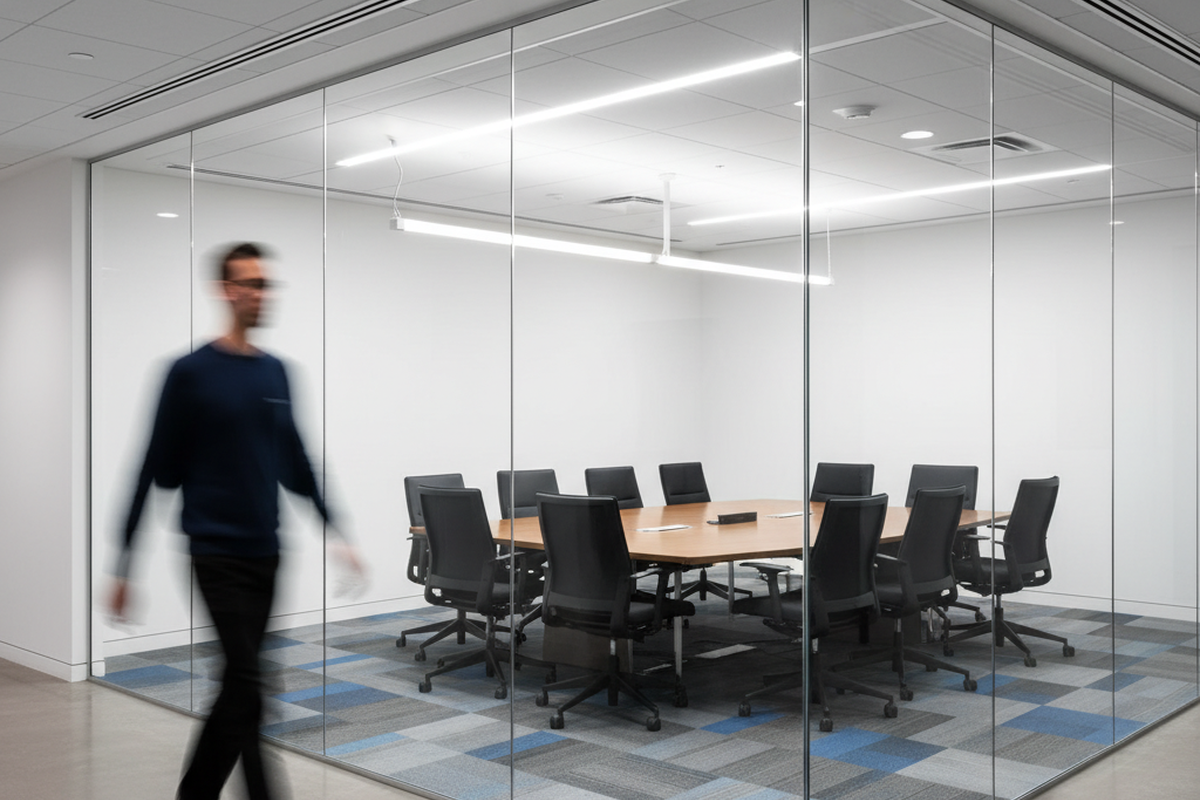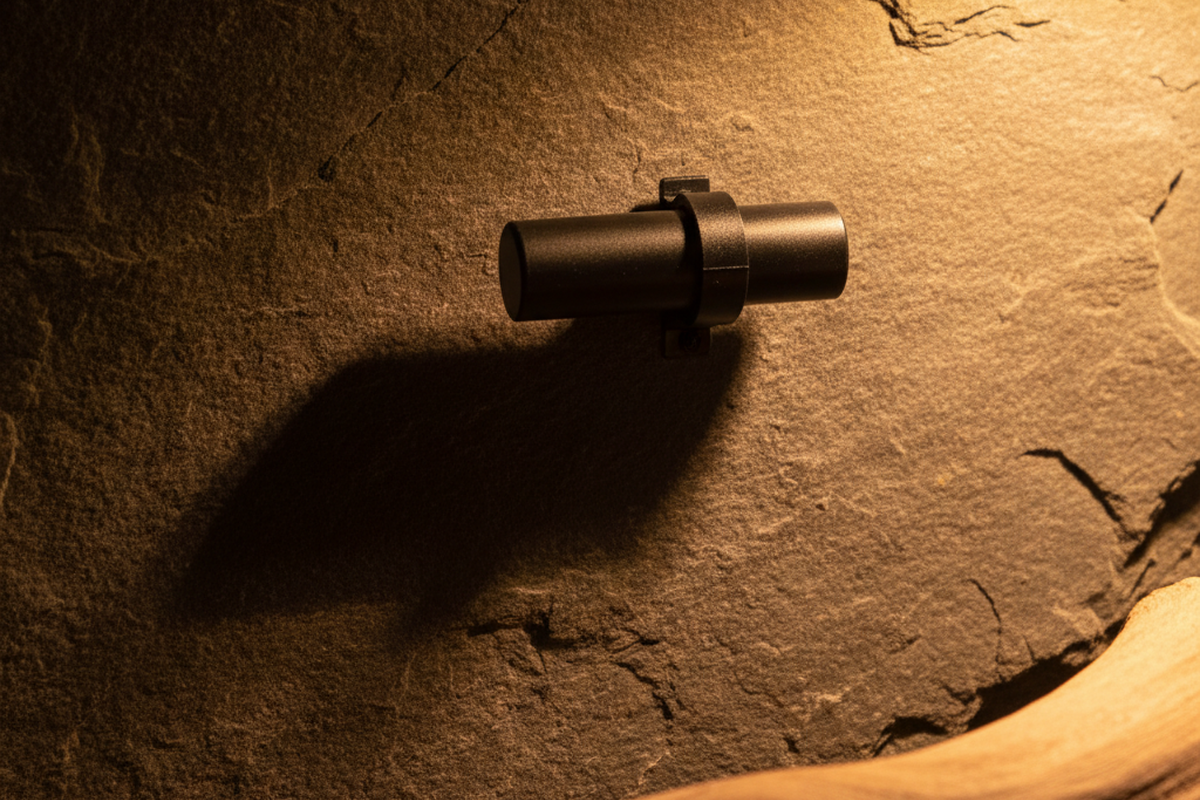Energy waste in hotels is no mystery. Walk through any property at 3 AM, and the evidence is everywhere. Corridors glow with full lighting for sleeping guests. Housekeeping closets run air conditioning for mops and cleaning carts. Guest rooms, checked out hours ago, continue to cycle heating and cooling, maintaining a perfect temperature for empty walls and furniture. The waste is pervasive, measurable, and expensive.

For midscale hotel operators, the challenge isn’t diagnosing the problem but deploying a solution that works within tight budgets, with limited maintenance staff, and against the unforgiving reality of guest expectations. Complex building automation systems promise control but demand ongoing software subscriptions, delicate network infrastructure, and dashboards that require logins no one has time to manage. The result is often expensive shelfware delivering marginal results.
Stand-alone occupancy sensors offer a different path. They operate autonomously, switching loads directly based on detected presence without needing centralized control, cloud connectivity, or specialized training. For properties where energy savings must pay for themselves quickly and reliability can’t hinge on IT support, this simplicity isn’t a limitation. It’s the entire value proposition.
This is a practical guide to deploying Rayzeek occupancy control in midscale hotels. We’ll cover the deployment sequence, the financial validation operations teams need, and the hard boundaries that prevent guest complaints from undermining the project. The focus is on what works in the field, not what looks impressive in a brochure.
The Invisible Energy Leak in Unoccupied Spaces
Corridors are designed for safety and wayfinding, so they are lit continuously. In a typical midscale property, hallway lighting runs 24 hours a day, regardless of occupancy. During the dead of night, when guest movement drops to near zero, the energy consumption remains unchanged. A 100-room hotel with four floors might have 800 linear feet of corridor, each fitted with fixtures burning thousands of kilowatt-hours monthly for spaces that see meaningful traffic only a few hours a day.
Back-of-house areas suffer a similar, if less visible, problem. Staff enter storage closets, laundry rooms, and break rooms intermittently. A housekeeper grabs supplies, flips a switch, and forgets to turn it off upon leaving. The lights stay on until the end of the shift, or longer. HVAC in these zones often runs on the same logic as guest areas, maintaining comfort levels for inventory and equipment. The cumulative waste across a dozen such spaces is significant, but because these areas aren’t guest-facing, the inefficiency is rarely scrutinized.
Maybe You Are Interested In
Guest rooms represent the largest opportunity and the greatest risk. When a room is vacant between checkout and the next check-in, the HVAC system typically keeps running. Most thermostats don’t distinguish between an occupied room and an empty one; they maintain a setpoint whether a human is there to benefit or not. In a 100-room hotel with 70 percent occupancy, 30 rooms sit empty on any given night, still consuming energy for heating, cooling, and often lighting. Over a month, the cost of conditioning and illuminating vacant rooms becomes a substantial line item that delivers zero guest value.
Occupancy-based control targets this continuous drain directly by breaking the link between space availability and energy consumption. The principle is simple: resources are used only when people are present to need them.
Why Stand-Alone Sensors Outperform Networked Systems for Midscale Hotels
The market offers two primary paths to occupancy-based control: networked systems that talk to centralized software platforms, and stand-alone sensors that operate independently. For large properties with dedicated facilities teams and budgets for ongoing software costs, networked systems can provide granular data and central oversight. For midscale operations, those benefits rarely justify the complexity, cost, and operational dependency they introduce.
The critical difference is the architecture of failure and maintenance. A networked system is a chain of dependencies. A sensor must talk to a gateway, which must connect to a cloud server or local network. The software platform needs updates, licenses, and monitoring. If any link in this chain breaks—a network outage, a firmware bug, a lapsed subscription—the control function is compromised. Troubleshooting requires IT involvement, vendor support, and time that midscale properties simply cannot afford to spend on lighting.
The Reliability of Autonomy
A stand-alone occupancy sensor has no chain. The device is installed in place of a standard switch or integrated into a fixture, where it uses passive infrared technology to detect occupancy and control the connected load directly. There is no gateway, no network, no cloud, and no software. Because the sensor operates in isolation, its function can’t be compromised by factors outside its immediate detection zone.

This autonomy translates to predictable uptime. The failure mode is simple: if the device fails, the load it controls defaults to a known state. Replacement is a matter of swapping a failed sensor with a spare in minutes, without reconfiguring a network or calling vendor support. For operations teams managing multiple properties on a tight budget, this independence is a defining advantage. The system just works, without logins, internet connectivity, or new points of failure.
The Hidden Cost of Dashboards Nobody Opens
Networked systems justify their complexity with dashboards displaying occupancy data, energy trends, and system health. In theory, this visibility enables data-driven optimization. In practice, midscale hotel operators rarely have the bandwidth to act on this data. The dashboard requires a login, which requires a password, which requires someone to remember it and take the time to use it. The data must then be interpreted before action can be taken. Each step introduces friction.
The reality is that most dashboards in midscale properties go unused, while the software licenses are paid monthly or annually regardless. These recurring costs, along with vendor updates and occasional training, erode the return on investment.
Stand-alone sensors avoid this overhead entirely. Once installed and configured, they operate without ongoing interaction. The savings are automatic, not dependent on someone reviewing data. For operations teams focused on cutting costs without adding workload, this set-and-forget reliability isn’t a compromise. It’s the optimal design.
How Occupancy Sensors Work
Commercial occupancy sensors rely primarily on passive infrared (PIR) detection. This technology registers changes in infrared radiation within a defined coverage zone. When a person moves through the zone, their body heat creates an infrared differential that the sensor reads as motion, triggering a connected load like a light or an HVAC relay.
The sensor’s lens design and mounting height determine its coverage zone. A ceiling-mounted sensor in a corridor might cover a 30-foot radius, while a sensor in a guest room is tuned for smaller, more obstructed spaces. Sensitivity is highest directly beneath the sensor and lower at the edges, which means placement is critical. A sensor mounted in the wrong location will produce unreliable results, either missing occupants or triggering falsely.
PIR technology has a key limitation: it detects motion, not presence. A person sitting still for an extended period may not generate enough infrared change to maintain detection, causing the sensor to interpret the space as vacant and turn off the lights. This is a known behavior, not a defect, and must be managed with appropriate time-delay settings. Understanding this is crucial for deploying sensors in spaces where stillness is common, like guest rooms.
It’s also important to distinguish sensors from simple timers. Timers operate on a fixed schedule, turning loads on or off at set times regardless of occupancy. Sensors, by contrast, respond dynamically to actual presence. This makes them far more effective in spaces with unpredictable usage like corridors and back-of-house areas, where human activity is intermittent and irregular.
A Phased Deployment for Maximum Impact
Rolling out occupancy sensors in a hotel shouldn’t be an all-or-nothing decision. A phased approach allows operations teams to validate savings, refine installation practices, and build internal confidence. The sequence matters. Starting in low-risk, high-impact areas generates immediate results that justify expanding into more sensitive zones.
The recommended approach is a two-phase sequence. Phase One targets back-of-house areas and corridors, where guest impact is minimal and savings are immediate. This phase serves as a pilot, allowing staff to master sensor placement and tuning in a forgiving environment. The energy savings from Phase One can then fund Phase Two, which extends control to guest rooms.
Phase One: Back-of-House and Corridors
Back-of-house areas are the ideal starting point. Spaces like storage closets, laundry rooms, and staff break rooms are used intermittently and have no guest visibility, offering immediate savings with virtually no risk. The waste here is often the easiest to capture, as lights are frequently left on for hours by staff focused on their tasks, not energy management.

Sensor placement is straightforward. A centrally positioned, ceiling-mounted sensor with a 360-degree detection pattern provides comprehensive coverage for most rooms. For narrow corridors, sensors with directional patterns are more effective. Most stand-alone sensors are designed to replace standard wall switches and operate on common line-voltage systems, making electrical compatibility a minor concern.
Time-delay settings in corridors must be tuned carefully. Too short, and the lights cycle annoyingly as people pass through; too long, and the savings diminish. For hotel corridors, a delay of 5 to 10 minutes is typically appropriate. This allows a guest to walk the length of the hallway and enter their room without the lights shutting off behind them, while still capturing savings during long periods of inactivity.
The results from Phase One are measurable and fast. Back-of-house lighting that previously ran 24/7 might drop to just 4 to 6 hours of actual usage. Corridor lighting can see overnight consumption fall by 70 to 80 percent. These reductions translate directly to lower utility bills within the first month, providing the financial proof needed to justify Phase Two.
Looking For Motion-Activated Energy-Saving Solutions?
Contact us for complete PIR motion sensors, motion-activated energy-saving products, motion sensor switches, and Occupancy/Vacancy commercial solutions.
Phase Two: Guest Rooms
Guest rooms are higher stakes. A sensor that cuts the lights while a guest is in the room will generate a complaint, trigger a maintenance call, and create a narrative that the new technology is a problem. This outcome must be avoided.
Placement in guest rooms must account for room layout and typical guest behavior. A ceiling-mounted sensor near the entry provides good initial detection, but guests spend significant time in bed, often relatively still while reading or watching television. A sensor with too short a time delay will interpret this stillness as vacancy and turn off the lights—the exact failure mode that undermines trust.
The solution is to configure guest room sensors with longer time delays and, where possible, to include an override function. An override, such as a manual wall switch, allows the guest to control the lighting directly, preserving savings when rooms are vacant while giving guests the control they expect.
Testing is non-negotiable. Install sensors in a few rooms—ideally rooms occupied by staff or trusted guests who can provide candid feedback. Monitor these rooms for a full occupancy cycle to verify that time delays are appropriate and the guest experience is seamless. The same principles apply to other occupied zones like conference rooms or fitness centers, each requiring settings tailored to its specific use pattern.
The Payback Math Operations Teams Can Defend
Energy efficiency projects are capital decisions. Operations teams must justify the investment to ownership with defensible financial projections. The payback calculation for occupancy sensors is straightforward, but it must be presented with transparency and realistic assumptions.
The cost equation is simple: sensor hardware plus installation labor. A quality stand-alone sensor costs between $20 and $60. A qualified electrician can typically install one in 15 to 30 minutes. For a 100-sensor project, the total cost might be around $6,000, including labor.
The savings depend on the property’s specific energy usage. As a baseline, calculate the current consumption of targeted zones. A corridor with ten 12-watt LED lamps running 24/7 costs about $10.50 per month to light (at $0.12/kWh). If sensors reduce runtime by 70 percent, the savings are roughly $7.35 per month for that corridor alone.
Scaled across a 100-room property, the monthly savings can reach several hundred dollars from corridors and back-of-house areas. Guest rooms add significantly more. A vacant room running HVAC and lighting can waste $5 to $10 per day. Across 30 empty rooms, that could exceed $4,500 a month. Sensors that eliminate this waste can drive payback periods of 12 to 24 months.
Consider a 100-room hotel that deploys 100 sensors across common areas and 50 guest rooms. With a total project cost of $6,000, the savings could look like this: $300 per month from reduced corridor and back-of-house lighting, plus another $1,200 from eliminating waste in vacant rooms. At a combined $1,500 in monthly savings, the payback period is just four months. Within the first year, the property saves $18,000, netting $12,000 after the initial investment. These are the kind of defensible, conservative numbers that build a strong business case.
Hard Lines to Prevent Guest Complaints
An occupancy sensor deployment fails the moment it prioritizes savings over guest experience. A single complaint about lights cutting off mid-shower can generate a negative review and a directive from management to remove the sensors. Avoiding this requires setting non-negotiable boundaries.
In guest rooms, the minimum time delay should be 15 to 20 minutes. This buffer accounts for periods of stillness, like a guest reading in bed. Anything shorter invites false-offs. In bathrooms, delays should be even longer, or sensors should be avoided if the risk cannot be fully mitigated.
Sensitivity thresholds must be tuned to the environment. An oversensitive sensor might trigger from curtains moving in an HVAC airflow, while an undersensitive one may fail to detect a guest. Tuning requires on-site testing, not reliance on factory defaults.
Get Inspired by Rayzeek Motion Sensor Portfolios.
Doesn't find what you want? Don't worry. There are always alternate ways to solve your problems. Maybe one of our portfolios can help.
Finally, an occupancy override is essential in guest rooms. Whether it’s a manual wall switch or a built-in mode, giving guests ultimate control is the fail-safe that protects their comfort and your investment.
The goal is a system that operates invisibly. Guests shouldn’t notice the sensors, and staff shouldn’t have to think about them. When implemented with care, occupancy control delivers energy savings that compound month after month without creating operational friction. The investment protects itself by disappearing into the background.



























